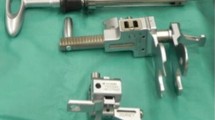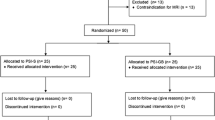Abstract
Multiple differing surgical techniques are currently utilized to perform total knee arthroplasty (TKA). We compared knee arthroplasties performed using either a measured resection or gap balancing technique to determine if either operative technique provides superior coronal plane stability as measured by assessment of the incidence and magnitude of femoral condylar lift-off. We performed 40 TKA using a measured resection technique (20 PCL-retaining and 20 PCL-substituting) and 20 PCL-substituting TKA were implanted using gap balancing. All subjects were analyzed fluoroscopically while performing a deep knee bend. The incidence of coronal instability (femoral condylar lift-off) was then determined using a 3-D model fitting technique. The incidence of lift-off greater than 0.75 mm was 80% (maximum, 2.9 mm) and 70% (maximum, 2.5 mm) for the PCL-retaining and substituting TKA groups performed using measured resection versus 35% (maximum, 0.88 mm) for the gap-balanced group. Lift-off greater than 1 mm occurred in 60% and 45% of the PCL-retaining and -substituting TKA using measured resection versus none in the gap-balanced group. Rotation of the femoral component using a gap balancing technique resulted in better coronal stability which we suggest will improve functional performance and reduce polyethylene wear.



Similar content being viewed by others
References
Berger RA, Crossett LS, Jacobs JJ, Rubash HE. Malrotation causing patellofemoral complications after total knee arthroplasty. Clin Orthop Relat Res. 1998;356:144–153.
Berger RA, Rubash HE, Seel MJ, Thompson WH, Crossett LS. Determining the rotational alignment of the femoral component in total knee arthroplasty using the epicondylar axis. Clin Orthop Relat Res. 1993;286:40–47.
Boldt JG, Stiehl JB, Hodler J, Zanetti M, Munzinger U. Femoral component rotation and arthrofibrosis following mobile-bearing total knee arthroplasty. Int Orthop. 2006;30:420–425. Epub 2006 Mar 7.
Crossett LS. Fixed- versus mobile-bearing total knee arthroplasty: technical issues and surgical tips. Orthopedics. 2002;25(2 Suppl):s251–s256.
Dennis, DA. Measured resection: An outdated technique in total knee arthroplasty. Orthopedics. 2008;31:940, 943–944.
Dennis DA, Komistek RD, Colwell CE Jr. Ranawat CS, Scott RD, Thornhill TS, Lapp MA. In vivo anteroposterior femorotibial translation of total knee arthroplasty: a multicenter analysis. Clin Orthop Relat Res. 1998;356:47–57.
Dennis DA, Komistek RD, Mahfouz MR. In vivo fluoroscopic analysis of fixed-bearing total knee replacements. Clin Orthop Relat Res. 2003;410:114–130.
Dennis DA, Komistek RD, Walker SA, Cheal EJ, Stiehl JB. Femoral condylar lift-off in vivo total knee arthroplasty. J Bone Joint Surg Br. 2001;83:33–39.
Fehring TK. Rotational malalignment of the femoral component in total knee arthroplasty. Clin Orthop Relat Res. 2000;380:72–79.
Griffin FM, Math K, Scuderi GR, Insall JN, Poilvache PL. Anatomy of the epicondyles of the distal femur: MRI analysis of normal knees. J Arthroplasty. 2000;15:354–359.
Hoff WA, Komistek RD, Dennis DA, Gabriel SM, Walker SM. A three-dimensional determination of femorotibial contact positions under in vivo conditions using fluoroscopy. Clin Biomech. 1998;13:455–472.
Incavo SJ, Wild JJ, Coughlin KM, Beynnon BD. Early revision for component malrotation in total knee arthroplasty. Clin Orthop Relat Res. 2007;458:131–136.
Insall JN, Hood RW, Flawn LB, Sullivan DJ. Total condylar knee prosthesis in gonarthrosis. A five to nine-year follow-up of the first one hundred consecutive replacements. J Bone Joint Surg. 1983;65:619–628.
Jennings LM, Bell CI, Ingham E, Komistek RD, Stone MH, Fisher J. The influence of femoral condylar lift-off on the wear of artificial knee joints. Proc Inst Mech Eng [H]. 2007;221:305–314.
Katz MA, Beck TD, Silber JS, Seldes RM, Lotke PA. Determining femoral rotational alignment in total knee arthroplasty: reliability of techniques. J Arthroplasty. 2001;16:301–305.
Kinzel V, Ledger M, Shakespeare D. Can the epicondylar axis be defined accurately in total knee arthroplasty. Knee. 2005;12:293–296.
Mahfouz MR, Hoff WA, Komistek RD, Dennis DA. A robust method for registration of three-dimensional knee implant models to two-dimensional fluoroscopy images. IEEE Trans Med Imaging. 2003;22;1561–1574.
Mantas JP, Bloebaum RD, Skedros JG, Hofmann AA. Implications of reference axes used for rotational alignment of the femoral component in primary and revision knee arthroplasty. J Arthroplasty. 1992;7:531–535.
Nagamine R, Miura H, Inoue Y, Urabe K, Matsuda S, Okamoto Y, Nishizawa M, Iwamoto Y. Reliability of the anteroposterior axis and the posterior condylar axis for determining rotational alignment of the femoral component in total knee arthroplasty. J Orthop Sci. 1998;3:194–198.
Poilvache PL, Insall JN, Scuderi GR, Font-Rodriguez DE. Rotational landmarks and sizing of the distal femur in total knee arthroplasty. Clin Orthop Relat Res. 1996;331:35–46.
Romero J, Stähelin T, Binkert C, Pfirrmann C, Hodler J, Kessler O. The clinical consequences of flexion gap asymmetry in total knee arthroplasty. J Arthroplasty. 2007;22:235–240.
Schnurr C, Nessler J, König DP. Is referencing the posterior condyles sufficient to achieve a rectangular flexion gap in total knee arthroplasty? Int Orthop. 2008 Oct 28. [Epub ahead of print].
Scuderi GR, Komistek RD, Dennis DA, Insall JN. The impact of femoral component rotational alignment on condylar lift-off. Clin Orthop Relat Res. 2003;410:148–154.
Whiteside LA, Arima J. The anteroposterior axis for femoral rotational alignment in valgus total knee arthroplasty. Clin Orthop Relat Res. 1995;321:168–172.
Yau WP, Chiu KY, Tang WM. How precise is the determination of rotational alignment of the femoral prosthesis in total knee arthroplasty: an in vivo study. J Arthroplasty. 2007;22:1042–1048.
Acknowledgments
We thank Kendall Slutzky for her assistance in manuscript preparation and numerous engineering students at the Center for Musculoskeletal Research (University of Tennessee) for their assistance in patient fluoroscopy testing and three dimensional kinematic analysis.
Author information
Authors and Affiliations
Corresponding author
Additional information
An institution of the authors (Center for Musculoskeletal Research) and one author (DAD) have received funding from DePuy, Inc. (Warsaw, IN).
Each author certifies that his or her institution has approved the reporting of these cases, that all investigations were conducted in conformity with ethical principles of research, and that informed consent for participation in the study was obtained.
This work was performed at Center for Musculoskeletal Research, University of Tennessee, Knoxville, TN and the Rocky Mountain Musculoskeletal Research Laboratory, Denver, CO.
About this article
Cite this article
Dennis, D.A., Komistek, R.D., Kim, R.H. et al. Gap Balancing versus Measured Resection Technique for Total Knee Arthroplasty. Clin Orthop Relat Res 468, 102–107 (2010). https://doi.org/10.1007/s11999-009-1112-3
Published:
Issue Date:
DOI: https://doi.org/10.1007/s11999-009-1112-3




